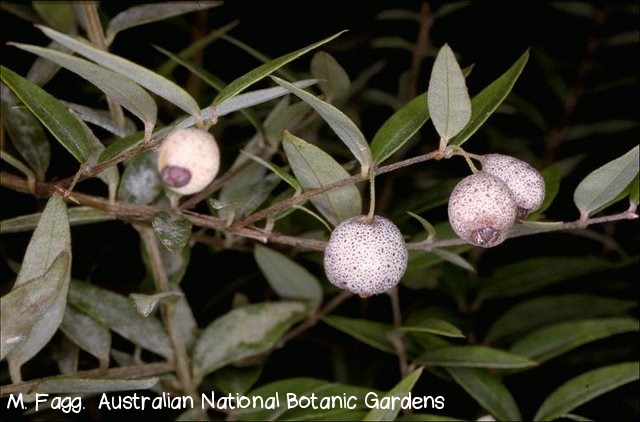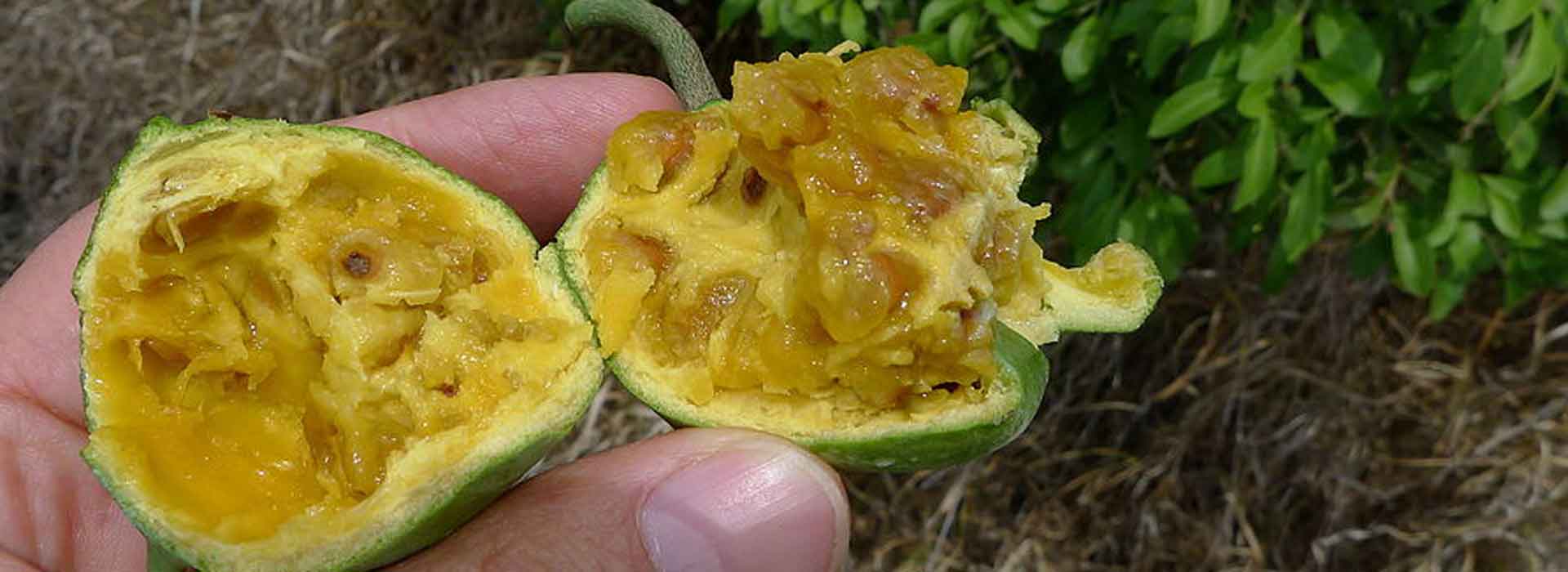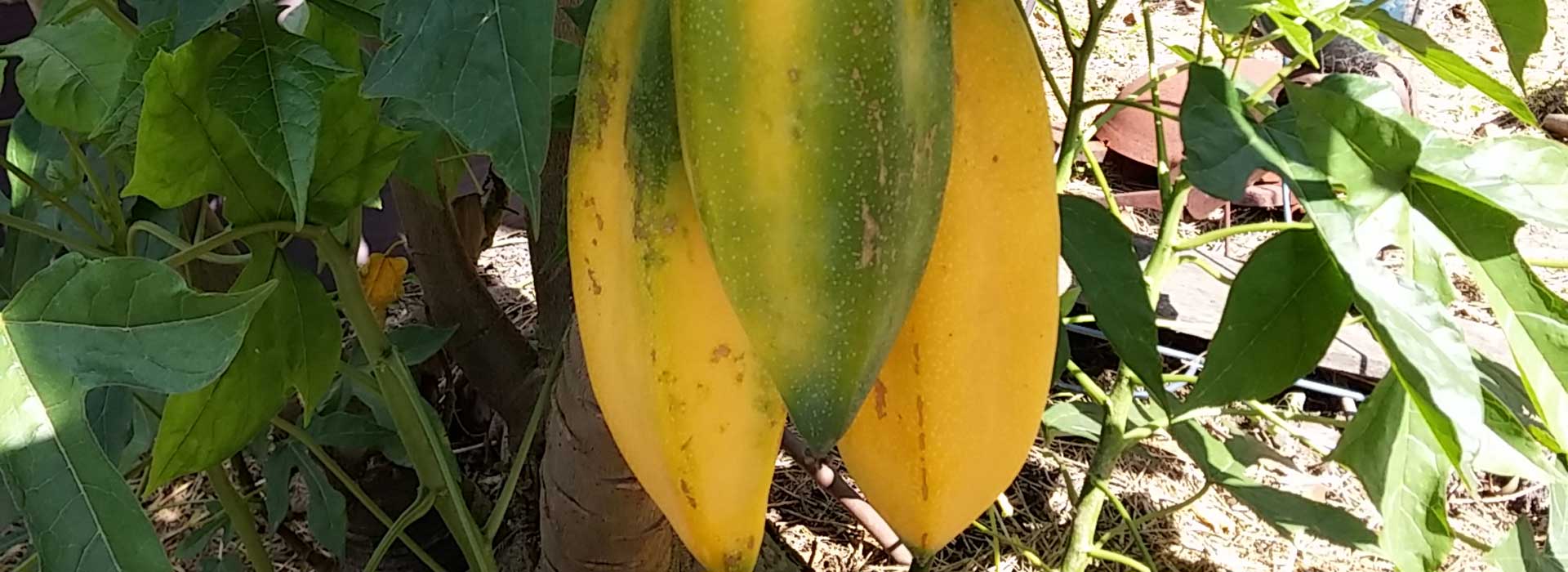Finger Limes
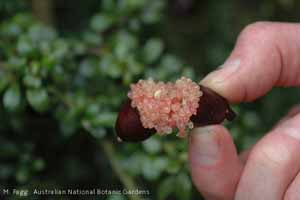 The fruit of the Australian finger lime Citrus australasica is sought after by top restaurants around the world. Often described as ‘lime caviar’ for its small bead-like crystals of tangy juice, this bushfood is used to pep up drinks, in desserts, as a garnish and even to make marmalade. For the home gardener, it is also an attractive tree, growing to six metres, and its thorns provide a perfect habitat for small birds. It is native to the rainforests of south-east Queensland and north-east New South Wales, but will grow elsewhere.
The fruit of the Australian finger lime Citrus australasica is sought after by top restaurants around the world. Often described as ‘lime caviar’ for its small bead-like crystals of tangy juice, this bushfood is used to pep up drinks, in desserts, as a garnish and even to make marmalade. For the home gardener, it is also an attractive tree, growing to six metres, and its thorns provide a perfect habitat for small birds. It is native to the rainforests of south-east Queensland and north-east New South Wales, but will grow elsewhere.
Planting schedule for warm, temperate and cool areas of Australia
Anytime except the height of summer when it can be too hard to make sure they get enough water.
Position
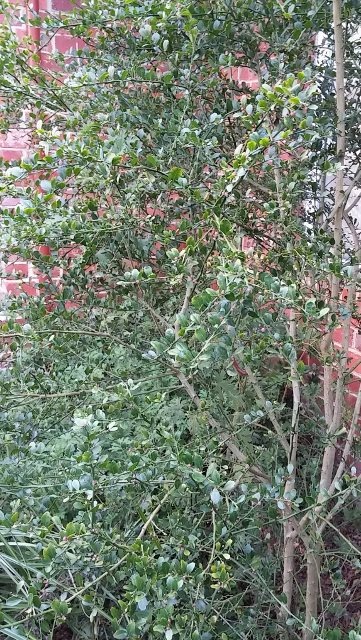 It is a good idea to protect trees from prevailing winds as the fruit can be damaged by the plant’s thorns. Finger limes thrive in dappled light as well as full sun. In cooler climates, a partly shaded north-facing site is preferred. They are able to withstand light frost.
It is a good idea to protect trees from prevailing winds as the fruit can be damaged by the plant’s thorns. Finger limes thrive in dappled light as well as full sun. In cooler climates, a partly shaded north-facing site is preferred. They are able to withstand light frost.
Finger limes, along with other citrus, make good hedges and espalier well against fences and walls.
Soil and fertiliser
They grow in a wide range of soils in tropical and subtropical rainforest. They are most commonly grafted onto exotic citrus with Citrus trifoliata being the most common and they are then particularly suitable for heavier soils. Grafted finger limes grow faster and withstand other climatic conditions because the grafted wood is usually taken from a mature tree. Like all citrus, finger limes prefer well-drained soil with a pH of between 6 and 7.
Mulch in spring and make sure the soil is kept moist in summer.
They require small amounts of fertiliser every 2 - 3 months. It is best to also give small quantities of soil conditioners like seaweed emulsion or worm castings regularly e.g. every 2 weeks.
Flowers and fruiting
The flowers are 10 to 14mm in diameter, white or pale pink and appear in late summer and autumn. They are followed by elongated fruits about 30-120mm long. The fruits ripen in winter through to spring and may be green, yellow, black, purple or red. The pulp is green, yellow or pink.
Propagation
Finger limes can be grown from seed, cuttings or grafting. They are slow growing and if grown from seed may take up to 15 years to mature. It is important to use fresh seeds. Semi-hardwood cuttings, like seedlings, are slow to grow and have a low success rate. Therefore, grafting on to Citrus trifoliata or a range of other citrus rootstock is preferable.
Pests and diseases
Citrus gall wasp Bruchophagus fellis is an Australian native insect pest. Citrus australasica is its natural host. The wasp has spread across the country in recent decades to areas of citrus production and to backyards. The wasp can reduce fruit size, tree vigour and yield.
The following practices can help limit the damage caused by citrus gall wasp: check your citrus trees between June and September when galls are at their most visible; prune off the infected branches by late August (before the adult wasps emerge); burn the infected branches. Do not put in the compost or green waste bin. Hang sticky yellow traps on the tree in mid-August as they attract and trap the emerging adults, but make sure you take the traps down by November as they also kill beneficial insects.
A biological form of control - introducing wasps that prey on citrus gall wasp - is used in orchards and home gardens. Megastigmus brevivalvus and Megastigmus trisulcus are natural enemies of citrus gall wasp. They lay their eggs inside the eggs of the citrus gall wasp and when their eggs hatch they destroy the host.
Megastigus brevivalvus is sold to home gardeners in some states, but it is only available for a two-week window around October/November. If you are able to get some of the parasitic wasps, they must be released soon after the citrus gall wasps have emerged.
Finger limes also suffer from similar pests and diseases to those of other citrus plants, such as crusader bug, spined citrus bug, bronze orange citrus bug, caterpillars, grasshoppers, psyllids, leaf miner, leaf hoppers, aphids, scale, nematodes and mealy bug. Sap-sucking insects can transmit both bacterial and viral diseases some of which can kill the plant.
Fungal diseases such as melanose, gummosis, phytophtera and dry fusarium rot may also be encountered.
Some ways to get rid of scale without using toxic sprays are: encourage predatory bugs into your garden (some predatory insects can be bought); rub off by hand; prune and dispose of infected branches, twigs and leaves; and apply horticultural oil (or home-made vegetable oil soap) which kills insects by smothering them.
Bronze orange bug can be removed by hand and drowned in a bucket of soapy water, but it is wise to wear gloves as they can squirt a nasty liquid. Spraying with eco-oil in winter and early spring may reduce numbers.
One of the non-chemical ways to deal with fungal disease like melanose is to prune off dead twigs and branches and remove diseased material from under the tree.
Cultivars
There are many cultivars of the Australian Finger Lime. They include: the 'Rainforest Pearl', a vigorous grower with pink fruit; and 'Alstonville' – a tall growing shrub producing dark green-black fruit with a pale green flesh. The 'Blood Lime' is a hybrid - a cross between a mandarin and a finger lime which boasts blood red flesh - the rind and juice may also be red.
Tastes vary. Some suggest trying the fruit before buying a tree to make sure you like the flavour. It is not always easy to find the fruit as demand exceeds supply. Try fruit markets in Sydney, Melbourne and Brisbane.
The trees can be bought at most nurseries.
We acknowledge the contributions of the indigenous food business Aussiecitrus to this article.
Recipes
Garlic & chilli prawns with pepperberry, saltbush & finger lime
A wonderful recipe for this unusual fruit can be found here http://heneedsfood.com/2013/12/garlic-chilli-prawns-with-pepperberry-saltbush-finger-lime/
References
Department of Primary Industry. NSW. www.dpi.nsw.gov.au/__data/assets/pdf_file/0016/320272/growing-australian-native-finger-limes.pdf
Australian Native Plants Society http://anpsa.org.au/
Australian National Botanic Gardens www.anbg.gov.au
Davidson's Plum
The Davidson’s plum has attractive foliage and brilliant coloured fruit. It is one of the thousands of native edible plants, yet not many people know this. Native to the rainforests of Queensland and NSW. It was enjoyed by Aboriginal people and is now popular with chefs around the country – particularly for jams, sauces, chutneys and even wine.
It is believed plants made up the bulk of the traditional Aboriginal diet. Their plant knowledge was extensive and included the whereabouts, relative tastiness, time of harvest of crops of yams, edible roots and flowers, berries, fruits and nuts. They also used the small seeds of native grasses to grind and make into bread.
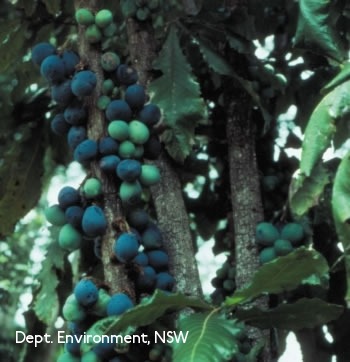
The Davidson’s plum has attractive foliage, brilliant coloured fruit – dark blue/purple on the outside and a deep reddish-pink on the inside. It might resemble the shape of the European plum, but they are not closely related and the native plum is far more sour than the fruit we are used to.
There are three species of the fruit: Davidsonia jerseyana, Davidsonia johnsonii and Davidsonia pruriens. All three trees are slender, but D. pruriens, also known as Ooray or Queensland Davidson’s plum, is tallest, growing up to 12 metres high. There are a few small-scale plantations producing the fruit in New South Wales and Queensland. D. jerseyana, native to lowland subtropical NSW, is considered endangered in the wild, but is widely cultivated. It reaches five metres high. D. johnsonii is a small tree with a spreading canopy and smooth leaves, also considered an endangered species in the wild.
Position
Davidson’s plum prefers warmer climate zones but will tolerate cooler regions if protected from frost. Being a native rainforest tree, the plant is best grown in a sheltered, part-shaded position in the garden with ample moisture and protection from damaging winds.
Soil and Fertility
The trees are found in their native habitat across a range of soil types. However, they appear to do best in deep, friable soils with plenty of organic material. They require good irrigation (or high natural rainfall), especially during flowering and fruiting.
Flowering and Fruiting
Flowers vary in colour from red through to pink, depending on the species. Fruits are borne either in panicles or grouped on the stem, again depending on the species. D. pruriens has larger fruit than the other species and they are produced in large clusters from the trunk or branches.
The fruit of D. jerseyana appear in early to mid-summer. Trees will bear in year 3.
D pruriens bears fruit in winter in its natural habitat but in cultivation, fruiting may extend to other seasons. This species will bear in year five or six or later.
Propagation
Fruit of D. johnsonii is infertile so propagation is done by clump division, cuttings or from suckers. The other species can be propagated by seed as well as the other methods. Davidson’s plum can be found in some nurseries around the country including Melbourne. It can also be ordered online.
Pests and Diseases
D. jerseyana is susceptible to fruit fly infestation. There are a number of sustainable ways to combat the fruit fly. These include: regular inspection for the presence of fruit fly larvae; setting traps; collecting fruit that has fallen to the ground, put in a sealed plastic bag and leave in the sun for 3-7 days; and employing chickens to scratch around under the tree to eat the larvae.
Birds, possums and flying foxes enjoy the fruit, so netting the trees at the appropriate time is wise. Caterpillars, moth larvae and beetles also attack flowers and fruit.
Pruning
Height is controlled by pruning off the tips. This also encourages multiple stems and fruiting.
Harvesting
Fruit picked just as it is beginning to turn purple will ripen readily off the tree. This will minimise the build-up of pests and prevent fruit falling to the ground to attract rodents.
Uses
In fact, Davidson’s Plum is not recommended for eating fresh but is excellent stewed, or preserved or made into jam using recipes for European plums. Some say you should double the amount of sugar that you would use in such a recipe. The flesh can be used in savoury dishes as well.
One of the impressive things going for the Davidson’s plum is its nutrients. It has more antioxidants than the blueberry, which is known worldwide for health benefits. It also contains potassium, lutein (a compound important for eye health), vitamin E, folate, zinc, magnesium and calcium.
It is best to eat the skin as well as the flesh of the fruit as the skin contains most of the nutrients.
Another benefit of Davidson’s plum is its intense colouring which can act as a natural food colour.
Meanwhile, research is being done into its preservative properties. When tested on some meats, a product made from Davidson’s plum extended the shelf life of the meat by 21 days in chilled conditions.
For a refreshing cordial see http://permaculture.com.au/davidson-plum-rainforest-flavours-in-the-kitchen/
References
Glowinski L. The complete book of fruit growing in Australia. Hachette Australia.
Midyim Berry
The midyim berry Austromyrtus dulcis is an easy to grow bushfood which occurs naturally in coastal areas ranging from northern NSW to Fraser Island in Queensland. It is (also known as midgen berry or sand berry). A favourite with First Nation's people it has a sweet, but tangy flavour which means it is nice to eat fresh, but also great in pies and preserves.
Wild Orange
Indigenous Australians enjoyed a diverse supply of interesting edible plants in the millennia before white settlement. Some, like macadamias, have been cultivated widely around the world for many years, but in the last few decades other lesser known “bush tucker” plants, of bushfoods, have been discovered by modern Australian chefs and gardeners. One of the estimated 5,000 edible plant species across Australia is Capparis mitchellii, commonly known as Wild Orange, Native Pomegranate or Mitchell’s Bumble Tree. The attraction of growing and eating these plants is not only their high nutritional value and unique flavours, but that they also provide habitat for native birds and insects and, therefore, a way of maintaining biodiversity.
Capparis mitchellii is a thorny tree which grows about six to eight metres high and four to six metres wide. It is slow growing. It apparently has a role in the dreaming stories of the Adnyamanthanha people of Northern Flinders Range, South Australia. It is not related to the orange of the Citrus genus. Instead it is of the same genus as capers (best known for their edible flower buds and fruit, both of which are usually eaten pickled).
Position
It is suitable for growing in temperate, Mediterranean, semi-arid or arid climates. It has a wide distribution in Australia being found in the Northern Territory, New South Wales, Queensland, South Australia and Western Australia. The plant is drought and frost tolerant, but does not like humidity. It grows best in full sun.
Soil
Capparis mitchelli will tolerate a wide range of soil types, including sandy, sandy loam and clay loam and needs good drainage. It prefers a soil pH of neutral to mildly acidic.
Flowering and fruiting
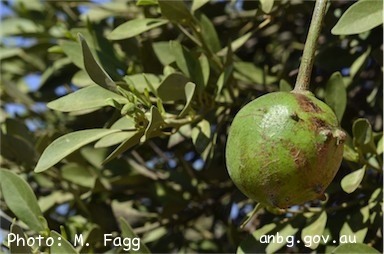 Attractive white or creamy-yellow flowers (3-4cm long) can be found at any time of the year. They have long protruding stamens and each flower only lasts for a day. They are followed by round, green fruit that hang from the branches on long curved stalks. When the fruit ripens it turns purplish or dull orange. The flesh becomes yellow to orange and soft with a sweet fragrance. The fruit are around 4-7 cm wide and can be eaten raw or used in cooking. Some say it is tasty, others call it astringent. It has also been described as tasting like passion fruit, with a kerosene aftertaste. The seeds are peppery and best discarded. The skin is bitter and inedible.
Attractive white or creamy-yellow flowers (3-4cm long) can be found at any time of the year. They have long protruding stamens and each flower only lasts for a day. They are followed by round, green fruit that hang from the branches on long curved stalks. When the fruit ripens it turns purplish or dull orange. The flesh becomes yellow to orange and soft with a sweet fragrance. The fruit are around 4-7 cm wide and can be eaten raw or used in cooking. Some say it is tasty, others call it astringent. It has also been described as tasting like passion fruit, with a kerosene aftertaste. The seeds are peppery and best discarded. The skin is bitter and inedible.
Pests and diseases
Caterpillars of the Caper White Butterfly (Belenois java) feed on the Wild Orange. They feed for about three weeks until fully grown then pupate. Butterflies emerge around December. Compared to other caterpillars of their size, they are not big eaters. As a host for the butterfly, the plant provides a good service to the environment. Birds can be a pest as they enjoy the fruit. It is one of the preferred foods of the Spotted Bower Bird.
Propagation
Capparis mitchelli can be grown from cuttings or propagated from seed. The seed does not need pre-treatment and it is possible to buy the seed online. Research has been done on propagating the plant by tissue culture. (The AgriForest Bio-Technologies Ltd company describes tissue culture as “a process that exposes plant tissue to a specific regiment of nutrients, hormones and light under sterile, in vitro conditions to produce many new plants, each a clone of the original mother plant, over a very short period of time.)
Uses
Capparis mitchelli has a high level of Vitamin C and is considered as valuable in the confectionery, flavouring and preservative industries. We couldn’t actually find any recipes, but it seems that the flesh can be stewed and can be used in desserts, cordials or savoury dishes like curries.
If you have a recipe, please let us know!
Banner image: John Tann from Sydney, Australia (Wild Orange fruit) [CC BY 2.0 (https://creativecommons.org/licenses/by/2.0)], via Wikimedia Commons
References
https://digital.library.adelaide.edu.au/dspace/bitstream/2440/77343/8/02whole.pdf
www.gardeningwithangus.com.au/?option=com_plant&view=plant&id=1371&from=botanical
https://en.wikipedia.org/wiki/Capparis_mitchellii
Pigface - Carpobrotus glaucescens
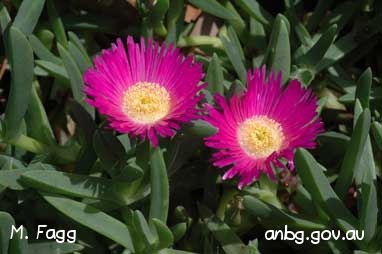 If you’ve walked over a sand dune on the way for a swim on a summer’s day in Eastern Australia you may have noticed a succulent plant with a spectacular bright pink flower growing beside the path.
If you’ve walked over a sand dune on the way for a swim on a summer’s day in Eastern Australia you may have noticed a succulent plant with a spectacular bright pink flower growing beside the path.
Chances are it was Carpobrotus glaucescens (also known as pigface, ice plant or angular sea fig). And you might be surprised to learn that not only is it native to Australia but it is also and edible bushfood. The red-purple fruit has a flavour described by some as like salty strawberry or kiwi fruit and by others as like salty apples1. Its thick, fleshy leaves can also be eaten – raw or cooked (the roasted leaves may be used as a salt substitute) and the juice from the leaves can be used to soothe stings or burnt skin2. The juice from the leaves can be mixed with water and used as a gargle for sore throats and mild bacterial infections of the mouth. The fruit has also been used as a laxative3.
Native Rosella
The beauty of Hibiscus heterophyllus is that it not only produces many lovely flowers over an extended period, it also has edible parts and useful fibres. And, it attracts native birds and a variety of insects so is a useful addition to gardens where natural, rather than chemical, pest control is preferred.
Indigenous to eastern parts of New South Wales and Queensland (right up to the Lockhart River on the very tip), the Native Rosella is one of 35 species of Hibiscus native to Australia. There are 250 species worldwide. While preferring warm, moist environments, the tall, fast-growing shrub has been successfully cultivated in Canberra and Melbourne. This plant should not be confused with the annual Hibiscus sabdariffa which is indigenous to West Africa but is naturalised in Australia. It has a number of similar uses and is also grown in Australia.
Position
The Rosella grows to between three and six metres tall and tolerates a range of soils and climates. Its natural habitat is warm, but it can survive in cooler climates if it is grown against a wall or fence where warm air is trapped or where heat is retained in the structure. It can also be grown in a container and moved into shelter during frosty conditions. The Rosella prefers full sun or light shade.
Flowering and Fruiting
The flowers of Hibiscus heterophyllus are large – up to 15cm in diameter. Their colour varies. In their natural environment, in Queensland the flowers tend to be a bright yellow and begin flowering in June, while further south they tend to be white and begin flowering in December. The centre of the flowers is bright red. There is a cultivar available in pink. The flowers are rich in nectar and honeyeaters take advantage, as do lorikeets. The nectar also attracts insects which in turn attracts insect-eating birds.
Like most Hibiscus species, the individual flowers last only a couple of days, but new flowers continue to open from spring through to summer.
Propagation
Hibiscus heterophyllus can be propagated from cuttings or by seed. Cuttings usually produce plants with more fibrous roots and more prolonged flowering. A seed-grown plant will have a tap root and a later, shorter flowering season. The fibrous roots allow the plant to be grown in pots, an advantage in cold areas such as Canberra where you may need to move the plants into shelter in the winter.
It is best to take cuttings from a healthy plant in late winter/early spring. Cut at an angle through the node and pot out in compost. The roots should take 6-8 weeks to strike.
Propagation from seed is relatively easy and no special pre-treatment is needed although germination will be faster if seed is abraded (with sandpaper) or soaked before planting.
For either method, keep the plants warm (about 20-25 degrees C) and away from direct sun. In windy spots, the plants may need to be staked because of their shallow root system.
Pests and Diseases
It is not particularly prone to pests and diseases, and like most plants, is more resistant the healthier it is. Hibiscus heterophyllus is targeted by pests that attack all species of hibiscus including the hibiscus beetle. This pest favours soft, new growth so avoid using high nitrogen fertilizers and manures which encourage this type of growth. Composts or seaweed extracts are more beneficial for flower and fruit production.
Scale insects can be a problem, but are easily managed by removing by hand or cutting off affected parts.
Pruning
Hibiscus heterophyllus grows as a rounded shrub, but, in time, may become sparse and need regular tip pruning to maintain its bushy shape. Prune by one third just after flowering. This is often done to train the plant into a hedge for screening and privacy. When pruning, make a good clean cut to minimise the risk of disease.
Uses
According to Wikipedia, author Jules Verne writes in his novel The Mysterious Island that “….nothing remained to be done but to find a plant fit to make the bow-string. This was the “Hibiscus heterophyllus” which furnishes fibres of such remarkable tenacity that they have been compared to the tendons of animals.”
Indigenous people traditionally used the fibre from the bark to make dilli bags (traditional bags used for transporting food), twine and hunting nets.
Flower buds can be made into a jam and used raw in salads or boiled as a vegetable. Petals can also be eaten in salads and for jam. Young shoots and roots are edible – raw or cooked.
A warning, though, in 1995 someone was reported to have suffered kidney damage from drinking Hibiscus heterophyllus tea. It is Hibiscus sabdariffa that is commonly used for tea, both as a refreshing drink and for its medicinal benefits mainly due to its antioxidant content.
Recipes
Native Hibiscus Jam (http://www.stgmagazine.com.au/pdf/Bushfood_25b.pdf)
Petals only from 10 large or 12 smaller hibiscus flowers. (They only last a day so pick them in the morning, store in the fridge and use into the evening).
¼ cup of lemon juice
½ cup of boiling water
2 cups of sugar
Detach petals from calyx (which surround the flower) and discard calyx. Chop petals finely and place in a deep pyrex bowl. Cover petals with lemon juice. Microwave* petals and lemon juice on high for 4 minutes.
Add boiling water and sugar and stir well. Cook 2 minutes then stir. Cook another 2 minutes, stir and then cook 2 minutes more and stir. Let cool for one hour.
When cool, cook for 2 minutes, then stir. Test whether jam gels by placing a small amount on a cold plate. If needed, continue cooking but no more than 2 minutes at a time. Pour into a sterilised jar.
This recipe produces a rich spread with the consistency of honey. It has a distinctive flavour and is delicious on toast or scones. Can be used as a glaze or diluted with white vinegar for sauces or marinades.
*Times based on 600 watts on high. Adjust times as needed.
Banner photo: Black Diamond Images.
Further reading
www.hibiscus.org/species/hheterophyllus.php
http://anpsa.org.au/h-het.html
www.stgmagazine.com.au/pdf/Bushfood_25b.pdf
www.hort.purdue.edu/newcrop/morton/roselle.html
Babaco
Babaco Carica pentagona is compact, high yielding and more frost tolerant than its close relative papaya (or paw paw) – an excellent candidate for sustainable gardens around the country.
A native of Ecuador, the herbaceous shrub is grown commercially in New Zealand, Israel and southern California. Its fruit, which is yellow when ripe and shaped like a torpedo, is sometimes called Champagne Fruit for its refreshing, effervescent flesh. Some say it tastes like a cross between strawberry, papaya and pineapple.
Position
The babaco grows to about 2.5 metres and does best in a mild, fairly humid climate. It must get enough sun or it will not set fruit. It only tolerates light frosts, though if it loses leaves in heavier frosts, it may recover. Plant in a position protected from wind and preferably shaded from hot afternoon sun.
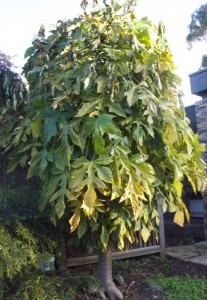 Soil
Soil
It needs a well-drained soil enriched with organic matter. It is fast growing and should be fertilised often especially during the fruiting season. Use a good quality fertiliser and mulch (composted chicken manure is recommended) and water well. Keep mulch and fertiliser away from the stem. Babaco will grow well in a large container as long as a good, free draining potting mix is used. Babaco does not tolerate salty soil and it is best to avoid watering with grey water.
Flowering and fruiting
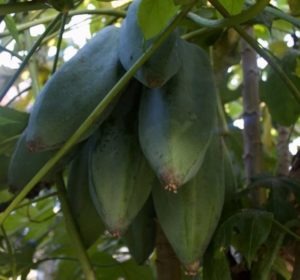 The large, palmate leaves are on long leaf stalks that radiate from the trunk. The flowers, which are all female, form on the developing trunk. The fruits set straight after flowering and start to expand quickly. They are pentagonal in shape, pointed at the apex and rounded where they attach to the stem. As they ripen yellow patches appear on the green skin and these spread until the whole fruit is yellow and ripe. The fruit can be picked when patchy and will ripen off the plant. The fruits lowest on the stem ripen first. The average lifespan of a babaco plant is eight years and it may produce between 30 and 60 fruit a year.
The large, palmate leaves are on long leaf stalks that radiate from the trunk. The flowers, which are all female, form on the developing trunk. The fruits set straight after flowering and start to expand quickly. They are pentagonal in shape, pointed at the apex and rounded where they attach to the stem. As they ripen yellow patches appear on the green skin and these spread until the whole fruit is yellow and ripe. The fruit can be picked when patchy and will ripen off the plant. The fruits lowest on the stem ripen first. The average lifespan of a babaco plant is eight years and it may produce between 30 and 60 fruit a year.
Propagation
Babaco fruits are seedless and can therefore only be propagated by cuttings. Cut up either the old trunk or small branches and leave them to dry out for a few days. Then plant out in potting mix or compost. The plant does not need to be pollinated.
Pests and diseases
It is important that the babaco plant is in well-drained soil as it succumbs easily to root rot – too much water means it is difficult for the roots to get air, causing them to decay. There is not much one can do once the plant has root rot. One option, though, is to cut off and propagate the stem. Very humid conditions can trigger powdery mildew so allow plenty of air circulation. Apart from a susceptibility to some mites, babaco is relatively pest and disease free.
Pruning
For the best results, only one trunk should be allowed to grow. Remove shoots that form around the base of the plant. In early spring, allow one of these shoots to develop. This shoot will grow rapidly but will not flower and interfere with the current season’s fruit. After harvest, prune the main stem back to 20cm and the remaining shoot will now develop and become the next main trunk.
Uses
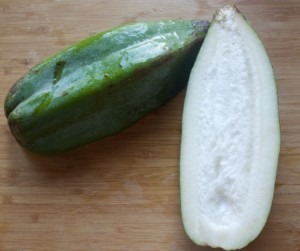 The fruit has thin edible skin and no seeds. It is not very sweet, but can be used in a tropical fruit smoothie, a chilled fruit cocktail or a fruit salad. Another option is to slice them, sprinkle with sugar and leave in the fridge for a few hours before serving. Unripe green fruit can be used as a vegetable in curries and chutney. The whole fruit can be used in jam or added to fruit pies. Babaco will keep on the shelf for up to four weeks. The ripe fruit is rich in Vitamin C. Babaco also contains the meat tenderiser papain, another good reason to use them in curries and stews with meat.
The fruit has thin edible skin and no seeds. It is not very sweet, but can be used in a tropical fruit smoothie, a chilled fruit cocktail or a fruit salad. Another option is to slice them, sprinkle with sugar and leave in the fridge for a few hours before serving. Unripe green fruit can be used as a vegetable in curries and chutney. The whole fruit can be used in jam or added to fruit pies. Babaco will keep on the shelf for up to four weeks. The ripe fruit is rich in Vitamin C. Babaco also contains the meat tenderiser papain, another good reason to use them in curries and stews with meat.
Planting
In cold parts of Australia, babaco from the nursery are at their best in spring and summer and it is wise to get them established in these warmer months. In frost free climates, plant all year round.
Recipes
Babacos mix well with other fruits, taking on their flavour and adding just that little special extra of their own. They are also a good base for chutneys and jams.
Green babaco chutney
This chutney complements Indian-style dishes. You need a mature babaco which is approaching ripening – the fruit should be green with a slight hint of yellow.
1 ½ kg green babaco, peeled and cut into cubes
60g fresh ginger, peeled and grated
6 garlic cloves, chopped
1 large onion, chopped
1 teaspoon salt
½ teaspoon chilli flakes
2 cups castor sugar
1 cup cider vinegar
5 black peppercorns
10 cardamom pods
1 bay leaf
Place babaco, ginger, onion, salt, chilli and sugar in a pot. Cover and stand overnight in the fridge. The next day, cook over a medium heat until thickened, about one hour.
Stir through vinegar, peppercorns, cardamom pods and bay leaf. Bring back to the boil, allow to cool slightly then pour into sterilised jars. Keep for one month before eating.
From: www.localfoodconnect.org.au/green-babaco-chutney/ Author: Stephen Onians
Babaco and Ginger Jam
1 ½ kg babaco pieces (green babaco can be used)
200g preserved ginger
1 ½ cups water
Juice 1 lemon
½ cup of ginger syrup
1kg sugar
Boil all except sugar for 15 minutes. Add sugar and boil hard until set.
Pour into sterilised jam jars and seal.
From: The Archives of the Rare Fruit Council of Australia
Megan Hallowes started her career as a journalist in South Africa, then worked as an editor and writer in Australia. She lives in Melbourne with her husband and two children and is working towards a bountiful garden of veggies, herbs and fruit trees.
Further Reading
http://www.fruitsinfo.com/babaco-tropical-fruits.php#Babaco Facts
http://www.crfg.org/pubs/ff/babaco.html




